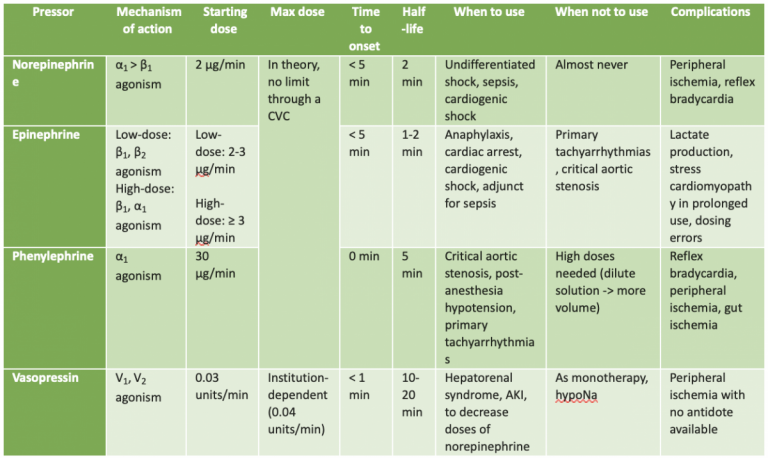Basics of PRESSORS, one bite at a time
PRESSORS:
Dr. Laura Di Taranti
Part 1: About norepinephrine
-
Mechanism of action: favors α1 agonism, which results in peripheral vasoconstriction. This increases preload, afterload, and SVR. There is also an element of β1 agonism which favors chronotropy and inotropy. However, because the α1 agonism is more significant than the β1 agonism, norepinephrine can theoretically cause a reflex bradycardia because the effect of the drug on SVR outweighs its effects on chronotropy and inotropy.
-
Uses: first-line pressor, great for almost everything
The Obligatory Table, for Comparison:

References
-
Cichon, Cathy. https://twitter.com/docscribbles/status/1158777133180657664?lang=en
-
Farkas, Josh. The Internet Book of Critical Care. Vasopressors. Accessed on December 7th, 2021. Available at https://emcrit.org/ibcc/pressors/.
-
Farkas, Josh. The Internet Book of Critical Care Podcast 78 – Vasoactive Agents. Published on February 20th, 2020. Accessed on December 7th, 2021. Available at https://emcrit.org/pulmcrit/pressors/.
-
Kim SM, Aikat S, Bailey A. Well recognised but still overlooked: norepinephrine extravasation. BMJ Case Reports 2012;2012:bcr2012006836:. doi: 10.1136/bcr-2012-006836.
-
Khanna, A et al. Angiotensin II for the treatment of vasodilatory shock. NEJM 2017;377:419-430. doi: 10.1056/NEJMoa1704154.
-
Manaker, Scott. Use of vasopressors and inotropes. Post TW, ed. UpToDate. Waltham, MA: UpToDate Inc. http://www.uptodate.com. (Accessed December 7th, 2021)
-
Parekh M, Andreae M. EM Resident. The Crashing Patient with Critical Aortic Stenosis. Published October 3rd, 2017. Accessed on December 9th, 2021. Available at https://www.emra.org/emresident/article/the-crashing-patient-with-critical-aortic-stenosis/.
-
Shields SH, Holland RM. Pharmacology of vasopressors and inotropes. In: Tintinalli’s Emergency Medicine: A Comprehensive Study Guide, 9th edition. New York, NY: McGraw-Hill Education; 2020: 133-137.
